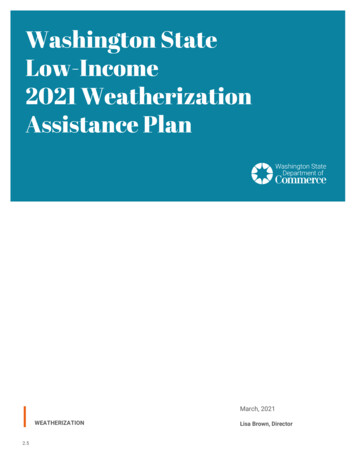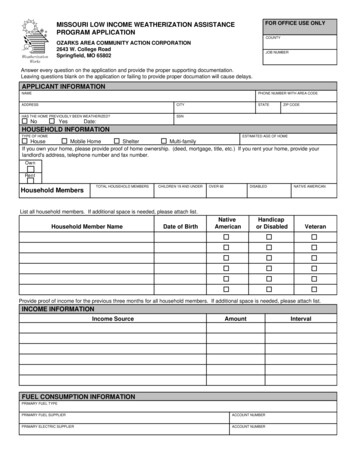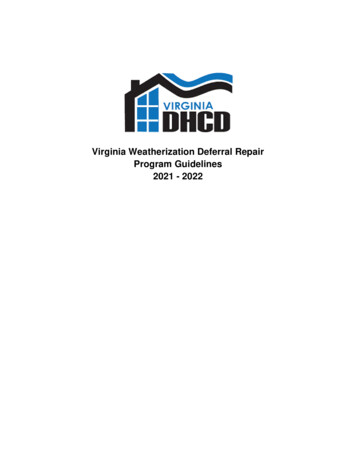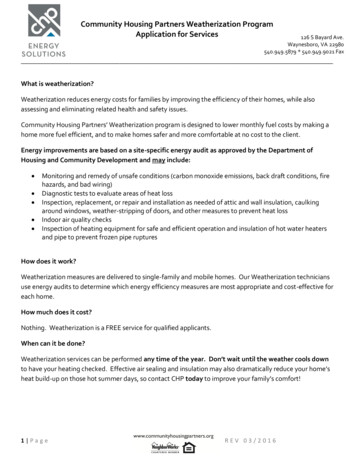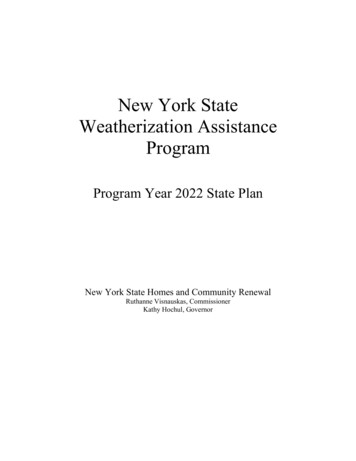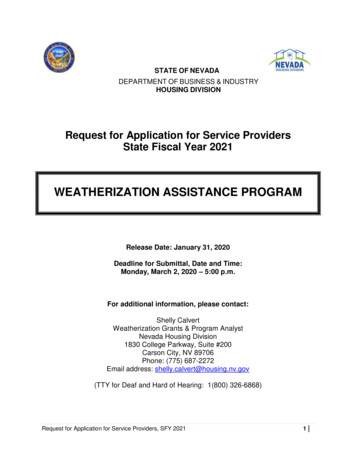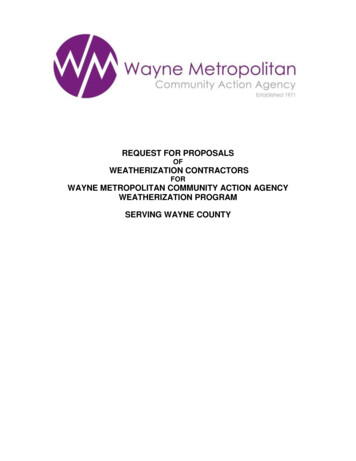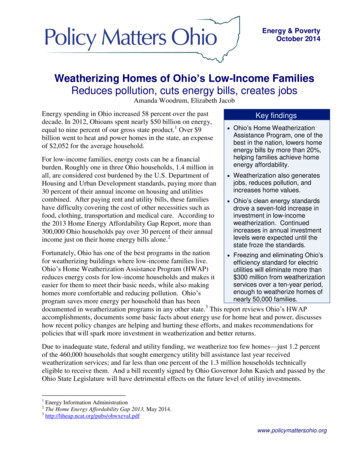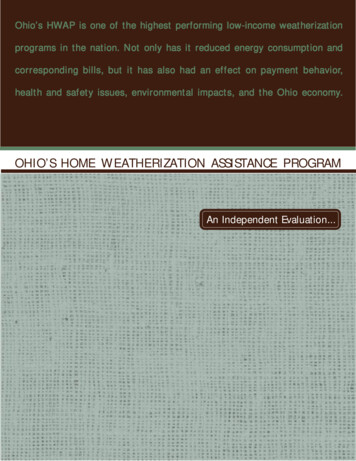
Transcription
Ohio’s HWAP is one of the highest performing low-income weatherizationHWAPprograms in the nation. Not only has it rreducededuced energy consumption andprogramsenergycorresponding bills, but it has also had an effect on payment behaviorbehavior,,correspondinghealth and safety issues, environmental impacts, and the Ohio economyenvironmentaleconomy.OHIO’S HOME WEATHERIZATION ASSISTANCE PROGRAMAn Independent Evaluation.
This report is based on studiesconducted by independent contractorsselected to evaluate and assess the HomeWeatherization Assistance Program.Table of ContentsKey Findings -------------------------- 2FindingsHistory of HWAP -------------------- 4HistoryHWAPProgram Context -------------------- 6ContextEvaluation Overview ---------------- 8OverviewEvaluation FindingsFindingsImpacts ------------------------ 9ImpactsProcess ---------------------- 11Field Site -------------------- 12
For more than 20 years, the HomeWeatherization Assistance Program(HWAP) has installed energy efficiencymeasures in the homes of Ohio’slow-income residents.Key FindingsThis method ofinsulation, called“tubing,” allowsfor a densepacking ofinsulationwithin the walls. Key findings include the following:Ohio’s HWAP saves more energyper household served than hasbeen documented for any otherstate’s low-income weatherizationprogram. Ohio’s technically innovativeapproach to weatherization is responsiblefor this result. Households that heat withgas — the great majority of HWAPparticipants — reduced gas used for spaceheating, on average, by 29 percent.Households with electric heat —the secondmost common type of space heating —reduced electricity used for space heating,on average, by 15 percent.The energy savings produced bythe HWAP program save Ohioratepayers 14 million over the lifeof the measures by reducing thecost of the Percentage of IncomePayment Plan (PIPP). Under PIPP,eligible low-income households pay utilities10 percent of their income for gas heat and5 percent towards their electric bill, or 15percent for electric heat. The differencebetween the amount paid by the householdand the actual bill is collected from allutility ratepayers. HWAP reduces the PIPPdeficit that ratepayers must “pick up.”Ohio’s HWAP program is soeffective that many householdsdon’t need to go on PIPP to retainutility service. PIPP participation isreduced by about 25 percent after HWAP.2
Key Findings continued.FindingsHWAP’s energy savings also rresultesult inHWAPAP’senergyenergy bill savings of more than 13energymoremillion for non-PIPP households thatparticipated in HWAP. These bill savingsHWAPare realized over the life of the measuresthat were installed in the year studied.These bill savings flow to non-PIPPhouseholds that pay their fullutility bills and to households that heatwith propane or oil.HWAP’s direct economic benefits exceedHWAPAP’sdirectexthe costs of the programprogramfrom 7 to 26 percent.frompercent.Depending upon the value counted forenvironmental benefits, the present valueof savings over the lifetime of measuresinstalled in homes is between 2.2 millionand 8.0 million greater than the total costsof the program. These economic benefitsconsist mainly of reduced fuel bills over thelifetime of measures installed throughHWAP. Some savings also flow fromhealth and safety related improvements,such as replacement of unsafe heatingequipment, that are made in a portionof homes served by HWAP.The evaluation team quantifiedreductions in air pollutantsdue to HWAP. The total annualHWAPreduction of CO2 emissions attributableto the program’s weatherization activitiesis equivalent to the annual emissionsfrom more than 4,600 average U.S.passenger automobiles.The total annual reductionof CO2 emissions attributable toHWAP’s weatherization activitiesequals the annual emissions frommore than 4,600 average U.S.passenger automobiles.The number of jobs and the level ofpersonal income in the state areareincreased by HWAP. The study teamincreasedHWAPevaluated the aggregate economic impactsof HWAP, finding that the program has anet positive impact on the state’s overalleconomy. After accounting for all economiceffects of HWAP — including federal taxpayments from Ohioans to finance federalHWAP grants to the state — both thenumber of jobs in the state and the level ofpersonal income are higher than they wouldbe without the program.The great majority of HWAP participantsgreatHWAPare satisfied with program delivery. PIPPareprogramdeliveryparticipants are motivated by the prospectof comfort improvement, and non-PIPPparticipants by the prospect of bill savingsplus comfort improvement. Both types ofparticipants learn about the program mostlythrough personal contacts. These findingsprovide information the Office of EnergyEfficiency can use in its continuedmarketing of HWAP. Hundreds of thousandsof eligible households are not yet served byHWAP.3
Ohio’s HWAP was designed to reducethe energy consumption of Ohio’slow-income households, makingenergy services more affordable.OriginHistory of HWAPHWAP Funding in Millions5040DOEHHSPVE30201001986 1987 1988 1989 1990 1991 1992 1993 1994 1995 1996 1997Ohio’s HWAP was designed to reduce theenergy consumption of Ohio’s low-incomehouseholds, making energy services moreaffordable. It does this by installing energyconservation measures in eligible homes, atno cost to the residents. The program alsoidentifies and repairs health, safety, andcomfort-related problems which arecommon in older homes often occupied bylow-income families. The program began in1977 and is operated by the OhioDepartment of Development’sOffice of Energy Efficiency.Weatherization treatments areadministered and carried out by localorganizations. These include communityaction agencies, local governments, andcommunity-based non-profit organizations.The HWAP programserved 250,000 lowincome householdsin its first 20 yearsof operation.Program funding peaked at 39 million in1988 and fell to less than 20 million for 1997.HWAP funds are provided by the U.S.Departments of Energy and Health andHuman Services (DOE and HHS) and from“oil overcharge” money (PetroleumViolation Escrow, or PVE). The graph to theleft shows the year-by-year breakdown ofprogram funding from1986 through 1997.4
History of HWAP continued.HistoryHWAPProgram TreatmentsLow-income weatherization efforts havechanged considerably over the past 20 years.From installing simple measures such asweather-stripping and storm windows,low-income weatherization has evolved intoa technically sophisticated approach that isbased on site-specific diagnostic testingand targeted treatments. Ohio’s HWAP hasbeen at the forefront in incorporating manynew approaches and in assessing theireffectiveness.The main measures provided by theprogram include:The local HWAP agency performs an initialenergy audit at each house to determinewhich measures are needed. This on-siteaudit also identifies health and safetyrelated problems that need correction. Thelocal agency, or the private contractor ithires, performs the work recommended bythe audit; in some cases a heating systemsub-contractor is also hired. After all thework is completed on a home, the localagency performs a final inspection toverify the quality of the work.in-home energy educationenergywall insulationattic insulationblower-door guided air sealingblower-doorheating system safety tests, rrepairs,epairs,and tune-ups (and rreplacementseplacements forsafety rreasons)easons)duct insulation and sealingfloor insulationhot water savings measuresmeasures(insulation blankets and low-flowblanketsshowerheads)energy-related home rrepairsepairsenergy-rgy-relatedBased on HWAPprogram records, theaverage costs for installedmeasures per treatedhome were as follows: The gauges on theblower door are usedto measure air leakagefrom the building.Single familySite built . 2,030Mobile home . 1,320Multi-familyBuilding . 2,760Suite . 9105
HWAP primarily serves householdswhose incomes are at or below125 percent of the federal poverty level.For a household of three, this isabout 15,000 per year.Demographicsand IncomeProgram ContextOhio is an urbanized state with a high levelof homeownership. Its poverty rates areonly slightly less than national averages.Countywide poverty rates are highestin the Appalachian foothills in thesouthern part of the state.PopulationDemographicsTotal Population in 1990 10.8 millionIn urban areas74%Senior Citizens13%Below Poverty 198912.5%Below Poverty 199414.1%Children 5-17Below Poverty 19936Households with incomes between125 percent and 150 percent of poverty canalso receive weatherization through HWAPif they participated in the Home EnergyAssistance Program (see below).19%0%20%HWAP primarily serves households whoseincomes are at or below 125 percent of thefederal poverty level, about 15,000a year for a household of three. In 1989,650,000 households fell into this category;by 1994, the size of this category grewto about 745,000.40%60%80%100%Other Low-IncomeEnergy ProgramsIn addition to HWAP, low-incomehouseholds in Ohio can participate in anumber of fuel assistance andweatherization related programs. Thelargest programs are fuel assistance fromthe Home Energy Assistance Program(HEAP) and the Percentage of IncomePayment Plan (PIPP). In addition,households with senior or handicappedmembers can participate in the Ohio EnergyCredits fuel assistance program. The majorgas utilities and some electric utilitiesprovide weatherization services. Localagencies and governments also provide avariety of housing programs for low- andmoderate-income households.
Other Low-IncomeEnergy PEnergyPrrograms continued.The Home EnergyAssistance ProgramThe Home Energy Assistance Program(HEAP) distributes fuel assistance fundsprovided through the U.S. Department ofHealth and Human Services. In 1995, HEAPprovided approximately 46 million to nearly330,000 households with incomes below150 percent of the federal poverty level.Also included in HEAP is an EmergencyProgram that is available to households thatare threatened with a utility shut-off orhave run out of bulk fuel such as oil orpropane.The Percentage ofIncome Payment PlanThe Percentage of Income Payment Plan(PIPP) is an extended paymentarrangement program available to lowincome customers of gas and electricutilities regulated by the Public UtilitiesCommission of Ohio (PUCO). Customerswith incomes below 150 percent of povertycan enter a PIPP agreement with their localutilities. They agree to pay 10 percent oftheir income to maintain utility service fortheir primary heating source, and/or 5percent of their income to maintain servicefor their secondary heating-related energysource. PIPP participation in December1995 included approximately 105,000 gasheating customers, 15,000 electric heatingcustomers, and 120,000 electric nonheating customers.“There are lots of families andelderly people that could use thesame kind of help I got, so I’vebeen telling everyone I can to calland see if they’re eligible.”7
The HWAP program is periodicallyevaluated. Evaluations provideinformation regarding programperformance to the Office of EnergyEfficiency and other partiesinterested in HWAP.Evaluation OverviewThe Office of EnergyEfficiency uses evaluationfindings in managing andimproving HWAP.Previous EvaluationsCurrent EvaluationOhio’s HWAP has been evaluated severaltimes. Previous evaluations examinedoverall energy savings, savings from clienteducation, durability of savings, technicalfield performance, and the effectiveness ofadministrative and other systems. The mostrecent evaluation1 was completed in 1992and studied the performance of the programin 1988. That study found average netsavings of 18.9 percent of gas usage (296ccf/yr.) for single family site-built houses.From 1996-8, the Ohio Department ofDevelopment’s Office of Energy Efficiencysponsored five interrelated studies ofHWAP for the year 1994-5. Services in thisyear were provided to more than 30,000people living in a total of 11,997 housingunits.1see Gregory, Judith M. and L. Nelson, “Fuel Savings Study 1988Program Year: Final Report,” prepared for State of Ohio Department ofDevelopment Office of Energy Efficiency by Cleveland State Universityand Applied Energy Research Group, June 1992.Included in the studies are:An impact evaluation, determiningHWAP’s effects on energy use, and itsdirect costs and benefits.An environmental impactenvironmentalassessment, quantifying thereductions in air pollutants and incarbon dioxide emissions as a resultof the program.An economic impact rreport,eport,quantifying the changes in overallstate employment and personalincome due to HWAP.A process evaluation, examiningprocessthe effectiveness of program delivery,and the reasons why eligiblehouseholds find and participate inHWAP.8A field site investigation, reviewing thequality and persistence of weatherizationwork done by HWAP delivery agencies ina small sample of homes.
Ohio’s HWAP is one of the highestperforming low-incomeweatherization programs inthe nation. Not only has itreduced energy consumption andcorresponding bills, but itImpactshas also had an effect onpayment behavior, healthand safety issues, environmentalimpacts, and the Ohio economy.HWAP ImpactSummaryENERGY BENEFITSRatepayer Savings in PIPPClient Energy Cost SavingsTOTAL ENERGY BENEFITSNON-ENERGY BENEFITSDisconnections Avoided per yearHealth and Safety ImprovementsEnvironmental BenefitsTOTAL NON-ENERGY BENEFITS (see note)PROGRAM COSTSHWAP TotalUtilityTOTAL PROGRAM COSTSTOTALIMPACT BY FUELGASELECTRICITYOTHER 11.0 m 7.8 m 18.8 m 3.4 m 2.0 m 5.4 m— 3.9 m 3.9 m 14.4 m 13.8 m 28.2 m585 3.0 m58 0.1 m— 0.7 m 0.5 m 3.8 m 0.3 – 6.1 m 4.6 – 10.4 m 21.7 m 2.0 m 23.7 m 2.2 m— 2.2 m 4.7 m— 4.7 m 28.6 m 2.0 m 30.6 mNET PROGRAM BENEFIT (Benefits minus Costs)VALUE 2.2 – 8.0 mNote: The value of benefits is based on savings producedover the lifetime of measures installed during Program Year 1994.All costs and savings are expressed in 1994 dollars.9
Impacts continued.Gas and ElectricityConsumptionThe Impact Evaluation quantified the gas andelectricity savings that resulted from HWAPfor single-family houses and multifamilyunits. These savings were then valuedeconomically, based on retail gas and electricrates in Ohio. They are reported in the tableon page 9, as are the cost savings inhouseholds heating with oil or propane.Who Receivesthe Energy ayment BehaviorHWAP participants that are PIPPcustomers are paying a percentage of theirincome for heating energy. Consequently,their own portions of the bills do not changefrom weatherization; rather, the reducedcost of heating means that the PIPPprogram pays less for these households.The savings go to reducing PIPP programcosts; however, HWAP reduces energy useenough that some participants can leavePIPP entirely.For HWAP participants that are not PIPPcustomers, savings are reducing thedifference between customer payments andfull retail bills and have therefore reducedutility disconnections by approximately onethird.Environmental Impacts10The energy savings from HWAP lead toconsiderable carbon dioxide emissionreductions, as well as reductions inemissions of sulfur oxides, nitrogen oxides,carbon monoxide, methane, and particulatematter. The emissions reductions resultfrom reduced burning of gas and oil inhome furnaces and from reduced burningof coal, oil, and gas by electric utilities,which lessens the need for costlyenvironmental controls.Health and SafetyMany low-income houses have old andpoorly maintained space heating and waterheating equipment, which can lead to healthand safety problems such as indoor airpollution, carbon monoxide poisoning,and fires and explosions from safetymalfunctions or gas leaks.HWAP has provided health and safetybenefits by addressing numerousequipment and wiring problems in lowincome homes. Significant resources havebeen devoted to identifying and repairingmany health and safety problems. Forexample, 2.7 million was spent on healthand safety measures in 1994, including thereplacement of 850 heating systems.Impact on EconomyHWAP produces a number of impacts onthe Ohio economy. The program reducesimports of fuel into the state. An economicimpact analysis was used to trace theeffects of HWAP on employment in Ohio.The analysis accounted for bothemployment increases due to clients andratepayers having more disposable incomeafter energy savings begin, andemployment decreases due to tax paymentsto fund HWAP and to reduced energy sales.The net effect from 1994’s costs andsavings is a modest increase in employmentequating to approximately 13 jobs lasting20 years.The economic impact analysis also foundthat HWAP, over the life of the measuresinstalled, increases the aggregate levelof economic activity in the state by morethan 5 million due to the 1994 program(discounted 1995 dollars).Other Program ImpactsLow-income weatherization programsprovide additional benefits to participants,utilities, ratepayers, and society at large.These benefits include improved participantcomfort, reduced gas service emergencycalls, and increased durability of the lowincome housing stock.
The Process Evaluation reportreviewed how program serviceswere delivered during 1994and 1995. The review foundhigh overall levels of clientsatisfaction, and a systemProcess Findingsthat efficientlydelivers professionalquality services.The Process Evaluation report reviewedhow program services were deliveredduring 1994 and 1995. The review foundhigh overall levels of client satisfaction,and a system that efficiently deliversprofessional quality services.The evaluation included:conductingtelephone surveyssurveyswith program participantsand non-participantsreviewing printedprogram materialsprograminterviewing programinterviewingprogramadministrative staffstaff,,service providers,serviceproviders,and national expertsexpertsin the design of energyservice programs forlow-income populationsThe Process Evaluation yielded thefollowing conclusions:Personal contacts are the majorchannel through which informationabout HWAP reaches the community.Saving money on utility bills andimproving comfort levels are the twoimprovingaremost important motivating factorsfor participants.These factors also were found to bepotentially important for nonparticipants.Clients expressed consistently highexprxpressedees of satisfaction with programdegreesprogramdegrdelivery mechanisms and personnel.deliveryTwo-thirds of participants surveyedgave HWAP the highest satisfactionranking used in the survey.Many of the non-participantscontacted are aware of theareawareprogram, but face other barriersprogram,to participation, such as confusionabout the eligibility requirements andapplication process for rental units.11
Targeting clients based on the usagelevel and screening for previousweatherization treatment would helpensure higher savings program wide.Field Site FindingsThe Field Site Investigation evaluated theinstallation quality of weatherization andhealth/safety measures and noted anymissed opportunities for energy savings.A number of the findings from theinvestigation have already led tochanges that have been incorporated inHWAP program operating standards.The investigation found that homes treatedby HWAP vary significantly in the amountof savings realized. While some of thesavings discrepancies are due to theoccupants, the majority are due to theselection of homes and the servicesprovided by the agencies.The Site Investigation found that:Houses that saved larger amountslargerof energy following weatherizationenergydid so due to high initial consumptionand more effective treatment.Houses that saved lower amountsof energy after weatherization hadenergylower levels of energy use to begin with,which provided fewer opportunities forinstallation of HWAP program measures.Targeting clients based on theargetingusage level and screening forscreeningprevious weatherization treatmentprevioustreatmentwould help ensure higher savingsensureprogram wide.programGood documentation wasmaintained by the agencies.Pre-existing conditions within the homecould be better documented.Potentially serious combustionsafety problems were identifiedproblemswereand have since been targeted by newprogram standards.“This is a wonderfulprogram that’s led bypeople who really careabout other people.”12
AcknowledgementsThis report is based on studies conducted by independent contractors selected to evaluate and assessthe Home Weatherization Assistance Program. Thecompetitively selected contractors were Proctor Engineering Group and Tellus InstituteGroupInstitute. The principalindiduals on the evaluation team were MichaelBlasnik and Tom Downey of PTomPrroctor; David Hill,Shawn Intorcio, and David Nichols of Tellus; andIntorcio,Tellus;Don Michael Jones of Residential Building Analysis.ResidentialThis report summarizes the findings and conclusionsof the evaluation team, and does not necessarilyrepresent the views of the Ohio Department of Development (ODOD). The detailed findings of theevaluation team are available, in separate reports,from ODOD’s Office of Energy Efficiency (OEE).The evaluation team received the cooperation of numerous individuals, including OEE staff, programcontractors, HWAP delivery agencies, the major gasand electric utilities of Ohio, the Public UtilitiesCommission, the Office of Community Services, andlast, but not least, hundreds of residents in low-income households who participated in surveys ofHWAP participants and non-participants.The rresultsesults and conclusionssummarized in the rreporteportare the sole rresponsibilityesponsibility ofthe evaluation team.areofthe
Weatherization Assistance Program (HWAP) has installed energy efficiency measures in the homes of Ohio's low-income residents. Key findings include the following: Ohio's HWAP saves more energy per household served than has been documented for any other state's low-income weatherization program. Ohio's technically innovative
